| Multiple Network Adapters |
This page covers both Windows95 and Windows NT4.
Networking with Windows95 and WindowsNT4 is usually an easy
job:
Install the "Network Adapter", add
"Protocol" and "Client" and
you are "talking" over the network.
The possibility to define MULTIPLE
protocols for a Network adapter (which is so easy to setup due to Microsoft's
NDIS support) is highly
appreciated by everyone, who tried to setup/configure multiple protocols on a
DOS based systems or Windows 3.x-system: It was often impossible !
The
same is true for installing MULTIPLE Network Adapters: A very difficult (often
impossible) task under DOS and Windows 3.x, also a simple job under Windows 95
and Windows NT4.
The biggest challenge:
IRQ-Resources
Since
the days of the IBM AT systems, the design of the systems has changed
dramatically:
| IMB AT | Modern Pentium II | |
| Clock: Screen resolution: Memory: Disk: Floppy disk: available IRQ's: |
6 Mhz EGA typical 1 MByte 20 MByte 1.44 MByte 16 |
300 Mhz UVGA (1280x1024 / 1600x1200) typical 16/32/64 MByte 4 GByte 1.44 MByte (plus CD-ROM) 16 ! |
In today's high-performance systems, we are still stuck with the
limit of maximum 16 IRQ-lines ("What is an
Interrupt ?"), which is turning into a serious problem
on today's Multi-Media Systems with Sound-Boards and SCSI-controllers, in some
cases no IRQ is anymore available forcing to switch OFF something else (usually
the second Serial-Port COM2, which is not used so often).
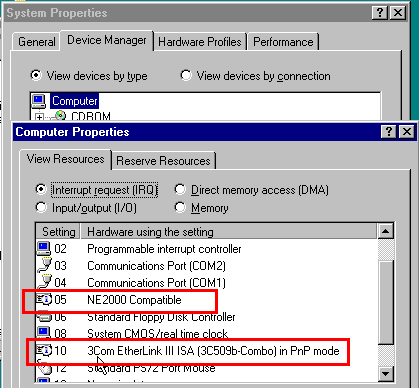 |
Windows95: Check in the Control-Panel "System", tab: "Device Manager" the "Computer"-properties to locate an unused IRQ. In my example, I did already install the second Network adapter. But if this system had a Sound-board (which usually takes 2 IRQ's) and a SCSI-adapter, no more IRQ would be available. |
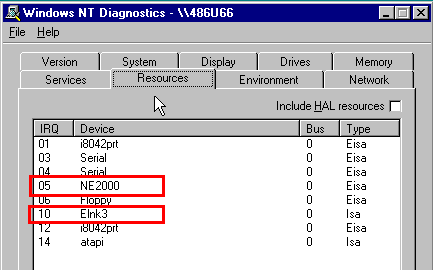 |
Windows
NT4: On Windows NT, check the "NT Diagnostics", Tab:"Resources". |
When installing a new network-board under Windows95, it
will automatically create a binding of ALL currently installed protocols to the
new board:
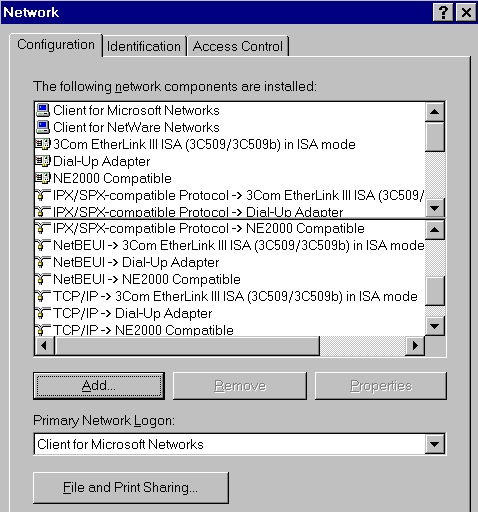 |
This screen dump is a "fake", because I had to make 2 screen shots to get the full info displayed. All protocols have a Binding to all Network cards. We should clean this up, keeping only the required bindings. |
When going to Multi-Network-Adapter/Multi-Protocol setups, it is
best to draw it up to get an overview on the goal to be achieved: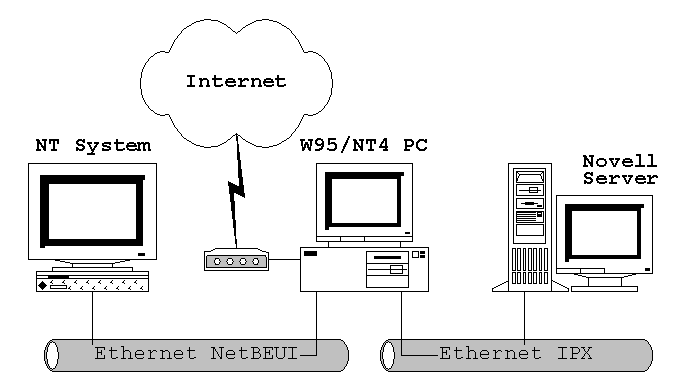
In
this example, I like to connect on different network cables:
- connect to a
Novell-Netware server via IPX protocol
- connect to a Windows NT system via
NetBEUI-protocol
- connect to the Internet using the Modem/Dialup-Adapter via
TCP/IP.
(In my example, I use 2 different
network-boards, but it is also possible to install 2 identical network-boards,
as long as they are configured for different IRQ and Port-address.
To avoid
another mis-understanding: if both the Novell-server AND the NT-system are on
the SAME network cable, you can connect to them using ONLY ONE Network-adapter
and BINDING multiple protocols to this one Network adapter. Please look to this
as an exercise)
Windows95:
(see below for Windows
NT4)
 |
to delete a Binding, select the combination of Protocol->Network board and "Remove" it. |
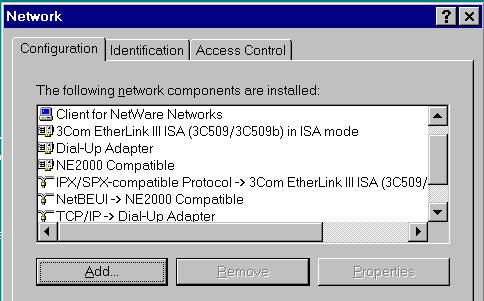 |
The "cleaned-out" version on the "Network", containing now only the required Bindings. We can now also verify the Bindings by checking the properties of the components: |
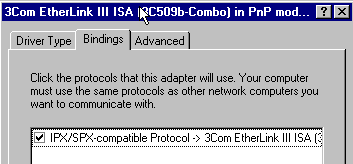 |
IPX has a Binding to the 3COM for the connection to the Netware Server. |
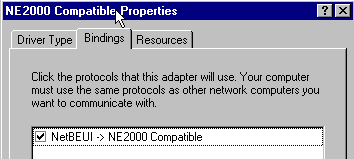 |
NetBEUI has a Binding to the NE2000 for the connection to the NT system. |
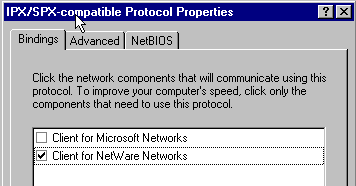 |
The IPX-protocol has a Binding to the Client for Netware Networks. (I manually un-checked the binding to the Client for Microsoft Network) |
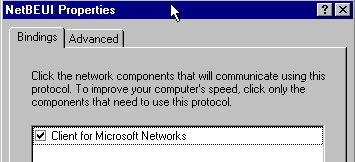 |
The NetBEUI-protocol has a Binding to the Client for Microsoft Networks. |
Lets now connect to these systems: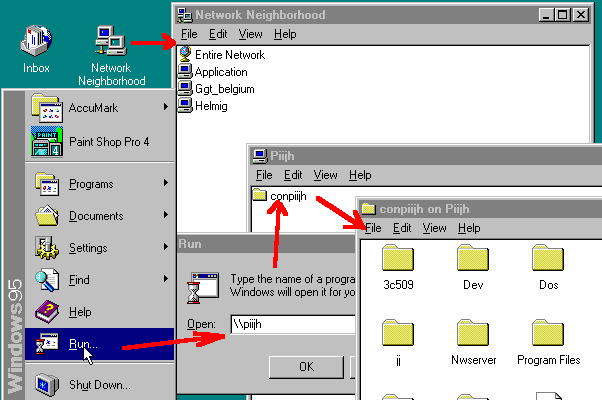
The Netware
server does show up in the "Network Neighborhood", but
(it is part of the Microsoft mystery of the "Browse-Master") the NT
system did NOT show up in the "Network-Neighborhood",
but I am able to connect to it by running the "Run"-command:
\\<server-name>, in my example: \\piijh.
WindowsNT4:
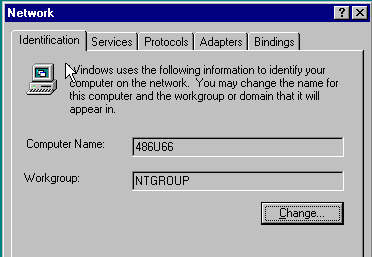 |
Lets check the "Network" applet in the Control-Panel. |
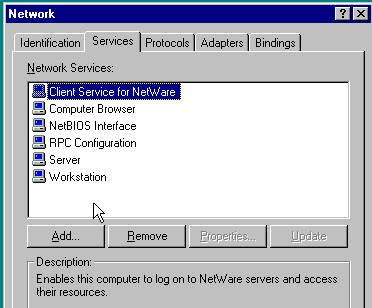 |
Since we like to connect to a Novell-netware server, we need in addition to the "Server" and "Workstation" (required to connect to the NT-system) the "Client Services for Netware". |
 |
We have the protocols: - NetBEUI to communicate with the NT-system - IPX to communicate to the Novell Netware server |
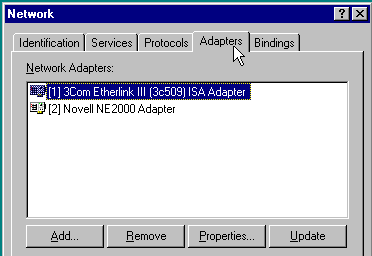 |
the 2 Network Adapters |
 |
The Bindings: Here we need to do the job. First, open (=expand the display) by clicking on the "+" signs. |
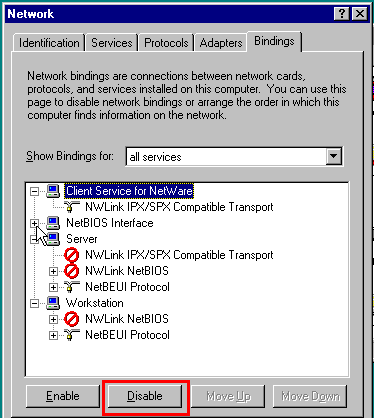 |
Then, select and "Disable" all not required Bindings. In this example: no need for the IPX-protocol to have a Binding to the Server and Workstation, which is used for connection to the NT-system. |
Then, we are ready to connect and browse the network:
Don't ask me why: But under Windows NT4, both the Novell-server(s)
AND the NT-system (PIIJH) are showing up in the
"Network-Neighborhood"
(each
time, when NT is able to do a job not possible/available on Windows95, I say to
myself:" Do NOT forget, that Windows95 is only the
little brother of the
big-boy NT ! ").